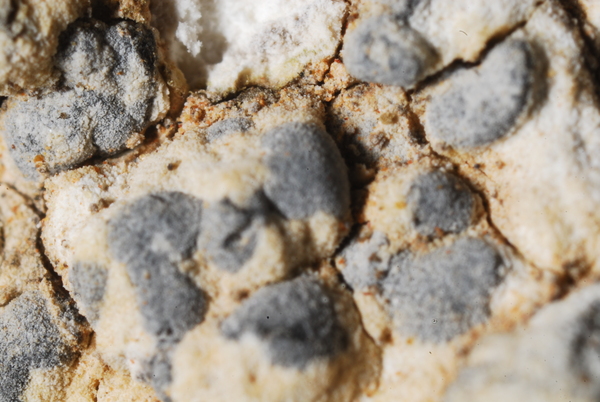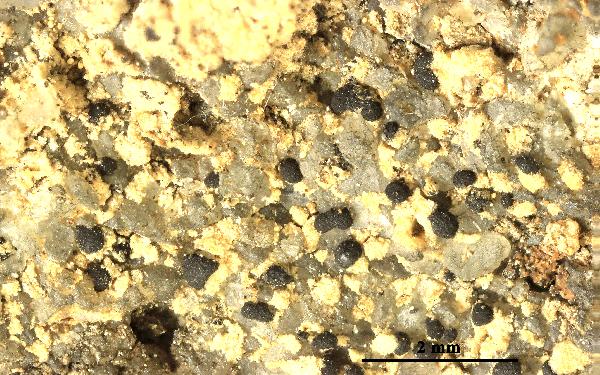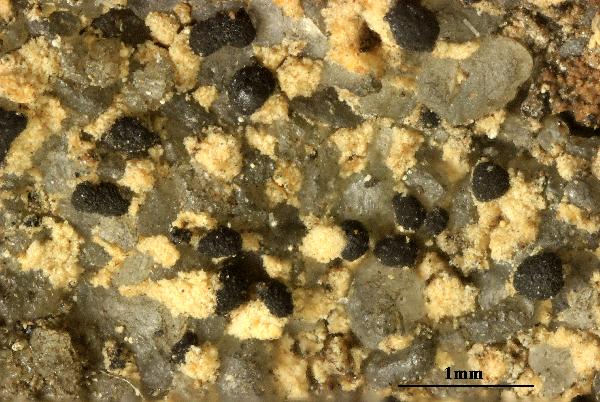Arthonia arthonioides (Ach.) A.L. Sm.
Monogr. Brit. Lich., 2: 213, 1911. Basionym: Lecidea arthonioides Ach. - Lichenogr. Univ.: 178, 1810.
Synonyms: Arthonia aspersa Leight.; Arthonia lecideoides Th. Fr.; Arthonia trachylioides Nyl.; Arthonia xylophila V. Wirth & P. James; Trachylia arthonioides (Ach.) Fr.
Distribution: N - Lomb. S - Camp, Bas (Puntillo & al. 2012), Si (Grillo & Caniglia 2004).
Description: Thallus crustose, episubstratic, thin to rather thick, soft, farinose, pinkish white (the pink colour fades in the herbarium), often inapparent in epiphytic samples. Apothecia arthonioid, round to rarely ellipsoid, up to 0.3-1 x 0.5 mm, with a flat to slightly convex, black, epruinose disc, without a distinct proper margin. Proper exciple poorly developed; epithecium dark brown, K+ pale olive-green; hymenium pale reddish brown, 30-40 µm high; paraphysoids c. 1-1.5 µm thick at mid-level, the apical cells often with a brown cap; hypothecium dark brown to black, 100-300 µm high. Asci 8-spored, broadly clavate, semi-fissitunicate, with a large apical dome and a distinct ocular chamber, Arthonia-type. Ascospores (1-)3(-4)-septate, hyaline, clavate, with one of the end cells distinctly enlarged, 11-17 x 4-6 µm. Pycnidia rare, black, immersed. Conidia straight, c. 7 x 2 µm. Photobiont trentepohlioid. Spot tests: thallus K-, C-, KC-, P-, UV-. Chemistry: without lichen substances.Note: a southern species, known from Europe and North America, found on acidic rocks and exposed roots under dry overhangs, also on dry undersides of trees in sheltered, humid situations, such as in forests.
Growth form: Crustose
Photobiont: Trentepohlia
Reproductive strategy: mainly sexual
Most common in areas with a humid-warm climate (e.g. most of Tyrrenian Italy)
In underhangs rarely wetted by rain
Commonnes-rarity: (info)
Alpine belt: absent
Subalpine belt: absent
Oromediterranean belt: absent
Montane belt: extremely rare
Submediterranean belt: absent
Padanian area: absent
Humid submediterranean belt: very rare
Humid mediterranean belt: very rare
Dry mediterranean belt: absent

Predictive model
Herbarium samples
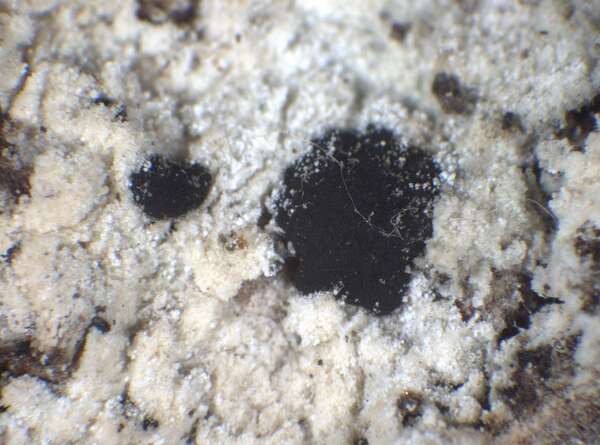

P.L. Nimis; Owner: Department of Life Sciences, University of Trieste
Herbarium: TSB (33862)
2003/01/23
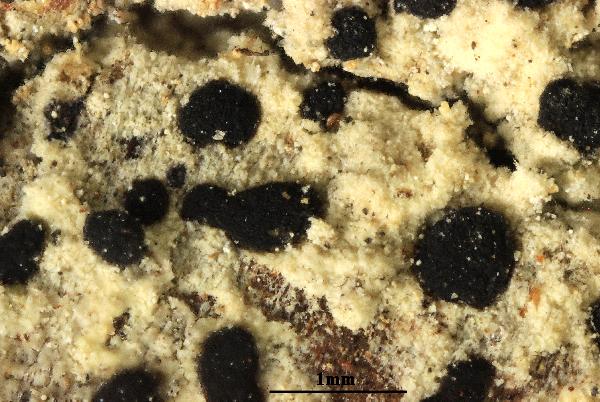

Felix Schumm - CC BY-SA 4.0
[VZR443], Bohemia austro-occidentalis, motes Šumava (Gabreta),
distr. Klatovy, Povyd í. in valle rivi Vydra loco Hálkova chata dicto,
850 m. Ad corticem Piceae excelsae. Leg. Z- Palice & O. Peksa,
6.07.2000, det. Z. Palice. EX A. VEZDA: LICHENES RARIORES EXSICCATI
NR. 443.
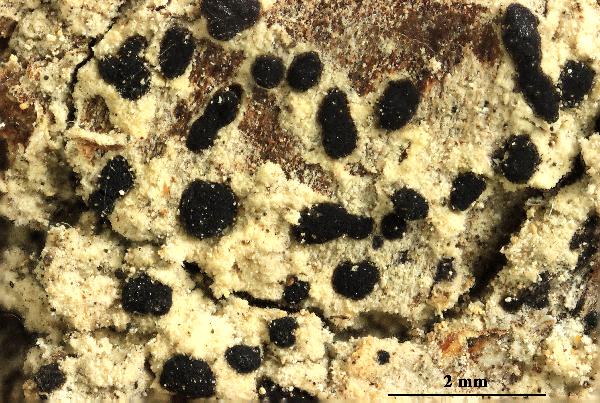

Felix Schumm - CC BY-SA 4.0
[VZR443], Bohemia austro-occidentalis, motes Šumava (Gabreta),
distr. Klatovy, Povyd í. in valle rivi Vydra loco Hálkova chata dicto,
850 m. Ad corticem Piceae excelsae. Leg. Z- Palice & O. Peksa,
6.07.2000, det. Z. Palice. EX A. VEZDA: LICHENES RARIORES EXSICCATI
NR. 443.
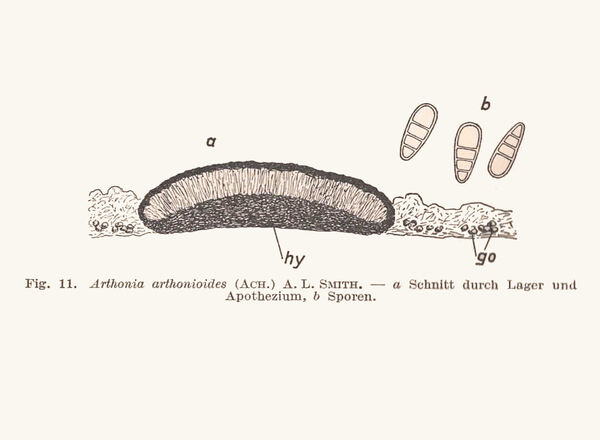
Redinger, K. (1938) Arthoniaceae, Graphidaceae . In Kryptogamen-Flora von Deutschland, Österreich und der Schweiz. Band 9, 2 Abt., Part 1 (G. L. Rabenhorst, ed.): 181–404. Leipzig: Borntraeger
Growth form: Crustose
Photobiont: Trentepohlia
Reproductive strategy: mainly sexual
Most common in areas with a humid-warm climate (e.g. most of Tyrrenian Italy)
In underhangs rarely wetted by rain
Commonnes-rarity: (info)
Alpine belt: absent
Subalpine belt: absent
Oromediterranean belt: absent
Montane belt: extremely rare
Submediterranean belt: absent
Padanian area: absent
Humid submediterranean belt: very rare
Humid mediterranean belt: very rare
Dry mediterranean belt: absent

Predictive model
| Herbarium samples |


P.L. Nimis; Owner: Department of Life Sciences, University of Trieste
Herbarium: TSB (33862)
2003/01/23


Felix Schumm - CC BY-SA 4.0
[VZR443], Bohemia austro-occidentalis, motes Šumava (Gabreta), distr. Klatovy, Povyd í. in valle rivi Vydra loco Hálkova chata dicto, 850 m. Ad corticem Piceae excelsae. Leg. Z- Palice & O. Peksa, 6.07.2000, det. Z. Palice. EX A. VEZDA: LICHENES RARIORES EXSICCATI NR. 443.


Felix Schumm - CC BY-SA 4.0
[VZR443], Bohemia austro-occidentalis, motes Šumava (Gabreta), distr. Klatovy, Povyd í. in valle rivi Vydra loco Hálkova chata dicto, 850 m. Ad corticem Piceae excelsae. Leg. Z- Palice & O. Peksa, 6.07.2000, det. Z. Palice. EX A. VEZDA: LICHENES RARIORES EXSICCATI NR. 443.

 INDEX FUNGORUM
INDEX FUNGORUM
 GBIF
GBIF

